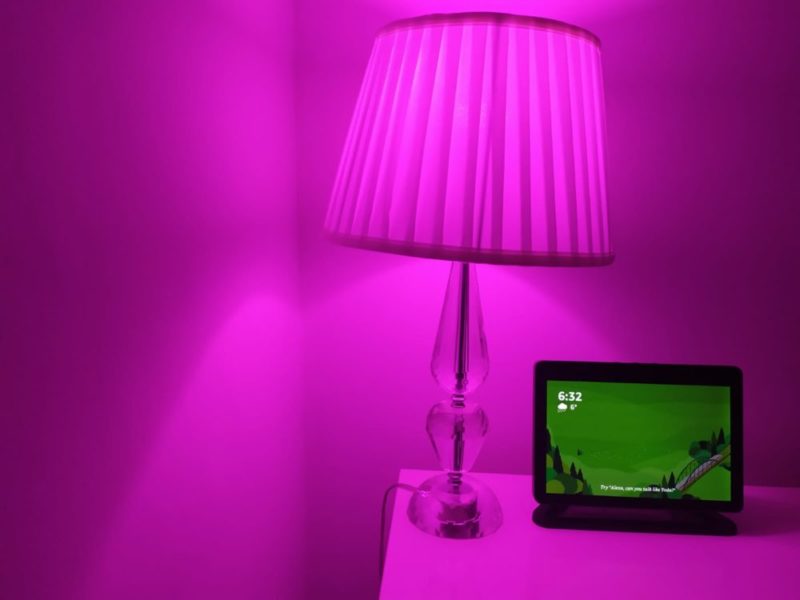Aside from the coronavirus threatening me and the rest of the world it has been a very positive start to 2020 as I continue extending my smart home to give me more independence, choice and control of my life.
My voice controlled smart home journey started back in autumn 2018 when the progression of my genetic muscle wasting condition, muscular dystrophy, meant that I could no longer rely on my hands and arms to do things due to progressive and severe muscle weakness. Turning the lights on, closing the blinds, and stepping up the thermostat had become impossible. At that point I decided that voice control of smart home devices was the way forward if I wanted to maintain, and even extend, my independence.
Two years ago, I wrote about my early experiences of building my smart home explaining how, with the help of Amazon Alexa smart speakers and connected gadgets such as window blinds, thermostat, lights and televisions, I was able to gain impressive levels of control and independence despite my physical limitations. However, there were two remaining pieces of equipment I wanted to gain voice control of and these were old devices that were made in the last century.
Bose home theatre system
The first was my Bose Lifestyle 30 home theatre system which I wanted to be able to control with my voice to stream music, radio stations and podcasts. This high quality, 20-year-old Bose is no longer manufactured and supported, but I wanted to make it smart and integrated into my Amazon Alexa smart home so it would stream stuff upon a voice command. Essentially, turn a ‘dumb’ stereo into a voice enabled device.
For many people nowadays this is fairly straightforward. Until recently Amazon sold a cheap device called a Echo Input that adds Alexa capabilities to old music systems by connecting via a 3.5 mm audio cable into the AUX input on the back of the Bose, and other music systems. However, the problem I was experiencing was when the Bose is powered on it always starts in CD mode by default and it is not possible for me to pick up and use the Bose remote control to switch it to the required AUX mode to stream music by Alexa speech commands because the remote control is too big and heavy for me to handle. It was also not possible to use my existing home radio frequency sender as the RF frequency Bose use is different and not compatible. Infrared control wasn’t an option either as my model of Bose does not support this.
For two years I looked for a solution with no joy. It wasn’t until last autumn when my friend Tim sent me a YouTube video of someone automating a 20-year-old Bose Lifestyle 20 via Google Home that I could see that what I wanted to do was in fact achievable. However, despite this evidence, every expert I spoke to told me it was still very complicated.
Being unable to get in contact with the YouTube poster I tried the private sector and, no joke, one company quoted me £5,000 for a custom solution to my problem! That was the highest quote I received and there was another for around £1,000.
With a prompt from AbilityNet who support people with disabilities and technology, I remembered Remap a UK charity with skilled volunteers who custom make equipment for disabled people, helping them achieve independence and a better quality of life. Remap headquarters gave me a couple of their branches in London to try to see if they could help. The first branch I tried I drew a blank; they had no one on their committee with computer skills.
However, with the second branch I got lucky and they had a computer expert who volunteers for Remap in his spare time. Remap put me in touch with Andy and I sent him the YouTube video, and the Lifestyle 30 service manual, which my local NHS environmental control service managed to obtain from Bose on my behalf, (Bose are very reluctant to hand out the service manual as the Lifestyle 30 is no longer manufactured). With other bits and pieces of useful information I had picked up along the way, from posting on various Alexa and hi-fi forums, Andy came round before Christmas to do a quick assessment.
Solution
The solution that Andy came back with at the start of January was to utilise the 3.5mm RS232 data input socket on the back of my Bose, which is normally used by engineers to run diagnostics on the music centre. A £15.00 Arduino micro processor was programmed to transmit serial codes we obtained from the Bose service manual to first enter the unit into data input mode, this mimics the remote control and then transmits the code to switch the Bose unit to AUX mode as if entered by the front switches on the unit or via the remote control. The TX/RX ports on the Arduino were set to 1200, 1, N and programmed to transmit the codes 1 second after the Arduino was powered on. A test switch was also included in the Arduino circuit to manually transmit the data to the Bose. The Bose and Arduino are powered by separate smart plugs, both controlled by my voice via an Alexa skill.
I have created a group in the Alexa app on my iPhone that will simultaneously power on the Bose, and the Arduino at the same time by the two smart plugs and with a three second delay when it is powered on, the Arduino will switch Bose to AUX mode and then Alexa will play a pre set playlist or radio station of my choice. It is almost instant. The noise you can hear on the video is simply the CD starting when the Bose is powered on but this stops after a few seconds when the Arduino switches the Bose to AUX mode. An Alexa voice command such as “music” or “turn on the Bose” is all that is needed to trigger all this action simultaneously! Now I can build music, radio, podcasts and so on into my existing Alexa routines, and create new routines.
Installation took only 10 minutes, and I now have full voice control of my Bose and the large and heavy remote control I cannot use can be put away in a drawer as I won’t need it going forward.
There is something extremely satisfying about breathing new life into a dumb but classic old piece of music kit and making it smart for the 21st-century. I could have gone down another route and spent a lot of money on a modern system with Alexa capabilities built in but I am really glad I didn’t. I am also very grateful that there are charities like Remap and volunteers like Andy in existence to help people like me. I do not know what I would have done without them.
Open sesame
In my 2018 smart home article I also wrote of my desire to control my existing automatic electric door opener, which is fixed to my front door, with Alexa voice commands. I have never been able to open my front door due to extreme muscle weakness in my arms and hands. My automatic door opener is manufactured by Record, a UK-based company who make many of the automatic door openers you see in shops and office buildings. The door opener works by a radio remote control unit, which when pressed opens and closes my front door so I can get in and out on my own. It is really useful and is my only means of access and exit. However, the problem I have been experiencing is that reaching for the remote control has been proving difficult, due to weakness in my arms, so over the past two years I have been looking for a way of opening and closing the front door with just my voice.
Now this issue has also been resolved. Last year, I saw a YouTube video of someone in the USA controlling driveway gates with Alexa using a cheap eWeLink wireless switch module. I sent the video to Record and and asked them whether they could do something similar with their automatic door opener. My request got a favourable response and their technical department experimented with my idea. However, It was a year before they got back to me to say they have come up with a solution that works.
I live in social housing and my landlord agreed to pay for the works, which are minor, not expensive, and do not invalidate the warranty,. I think in total the price including labour was £150. Quite a difference to a £5,000 quotation I received from another contractor two years ago! What is it about private companies and exorbitant quotations for custom solutions involving disability!
Record’s solution involves a smart WiFi switch controlled by the eWeLink Smart Home Control app on my iPhone, which is fully integrated with Alexa. The smart WiFi switch is hard wired to the door controller. From the eWeLink app you can configure the command you require to trigger the unit to open the door. So if you wanted, it could be “Micky Mouse” and the unit would trigger the door to open for a single operation. It is also possible to have the relay N/O, N/C or even a latch. Both the Alexa and the switch unit share my secure home Wi-Fi as a common platform to talk to one another.
I am also able to open the door from outside my flat because Amazon now offer Echo Buds, wireless earbuds with full Alexa integration, which means I can take Alexa and her voice capabilities everywhere now. Inside I can let people in, and myself out, with a voice command to my smart speakers, and outside in the street I can let myself in with my Amazon wireless earbuds.
I should also add that the solution controls both my flat door and the communal street door, and both doors also work manually in the normal way with a key, and with the radio remote control. Alexa is just a handy third option for me.
This customisation to an existing system is a good illustration of how receptive manufacturers and their R and D departments can be to custom requests. The Record engineer told me this is the first Alexa installation they have carried out on their equipment ever.
I couldn’t resist using “open sesame” as my first Alexa command for opening the door but I had to as Alexa didn’t understand something obvious like “open flat door”, she kept confusing it with another instruction! I will of course be changing this command regularly in case passers-by happen to cotton on to my Alexa command.
I think it’s great that Record have worked collaboratively with me. As one friend joked maybe they should offer me a seat on their board now! It has to be worth at least a non-exec position! The serious point, however, is that I wish more companies were more receptive to making modifications to their existing products to make them more disabled-friendly. Better still, design products from the outset with everyone’s needs in mind.
Final thoughts
As I have discovered over the past two years, voice controlled smart technology can be a great liberator for anyone who is unable to use your hands and arms as the result of a spinal injury, stroke, or a muscle wasting condition. It has certainly transformed my life in so many positive ways.
Whilst I am fairly technical, persistent, and stubborn in achieving my goals the problems that some disabled people may face with smart home technology is that it is very expensive and there are few sources of funding available. Some disabled people may also need assistance with installation, configuration and maintenance of devices and software.
My big idea to solve all these issues is to bring together government, big technology companies like Amazon, Google and Apple, the banks, and others and create a Motability-like charity that will help disabled people to lease or buy smart home devices using their disability benefits and backed up by a support service to assist with with advice, installation, and any problems that crop up.
In much the same way the Motability Scheme has, for the past 40 years, enabled people to get mobile by exchanging their mobility allowance to lease a new car, scooter or powered wheelchair, there should be something comparable for smart technology that can help disabled people with independence.
Whilst I have received great support from my NHS environmental control service, and charities like Remap and AbilityNet, in the Internet of things era we live in access to assistive technology is too important to be left to the good fortune of stumbling across a specialist charity. It should be a human right and there should be a formal scheme in place to meet the needs of people who could benefit from this technology, whether that is controlling their home, studying, or in employment – in short, so disabled people can enjoy the freedom and independence that so many of us take for granted.







Asif Alibhai
Colin, I was so glad to have found this just minutes before ordering a Broadlink box to achieve the same goal as you! Your article saved me wasting a lot of time, so thank you! Would you mind sharing perhaps some more detail on how I could replicate the same setup myself, please? I am familiar with SBCs etc but have never worked with Arduino before…
Any guidance you could share would be Ace!
Thanks,
Asif
Steve
Hi, are you able to share the code and the circuit diagram made the Bose connection work please ??
Thanks,
Steve